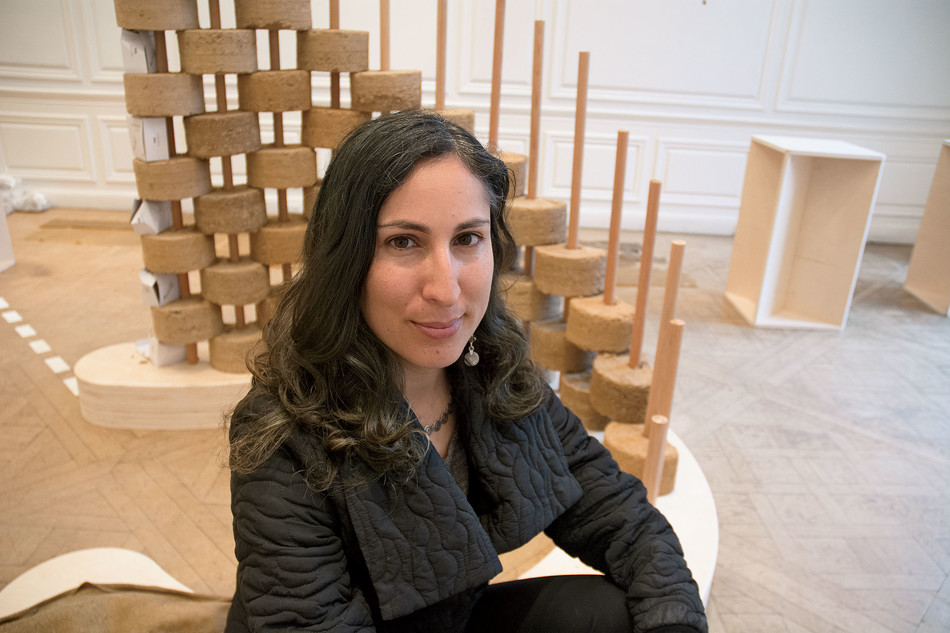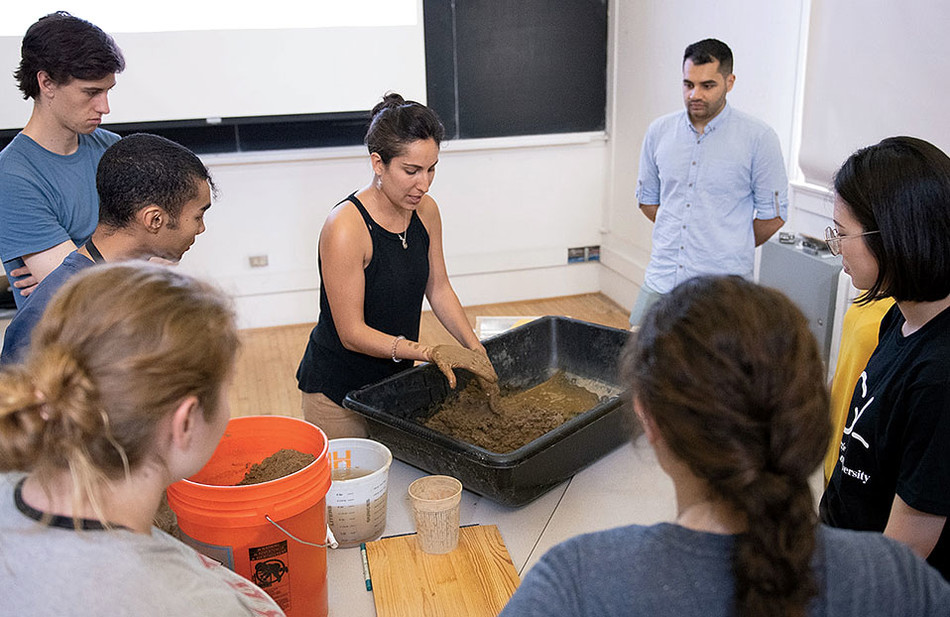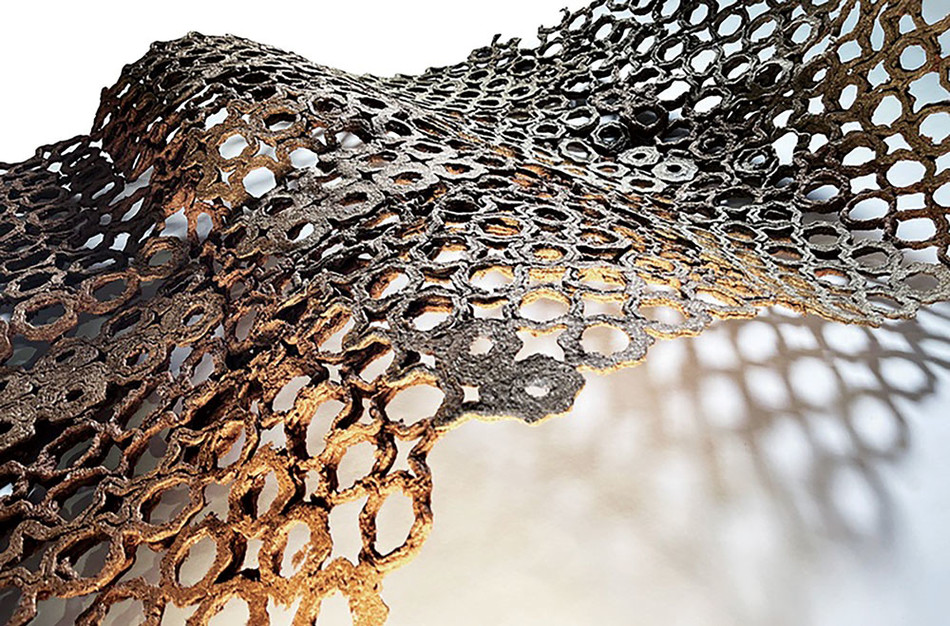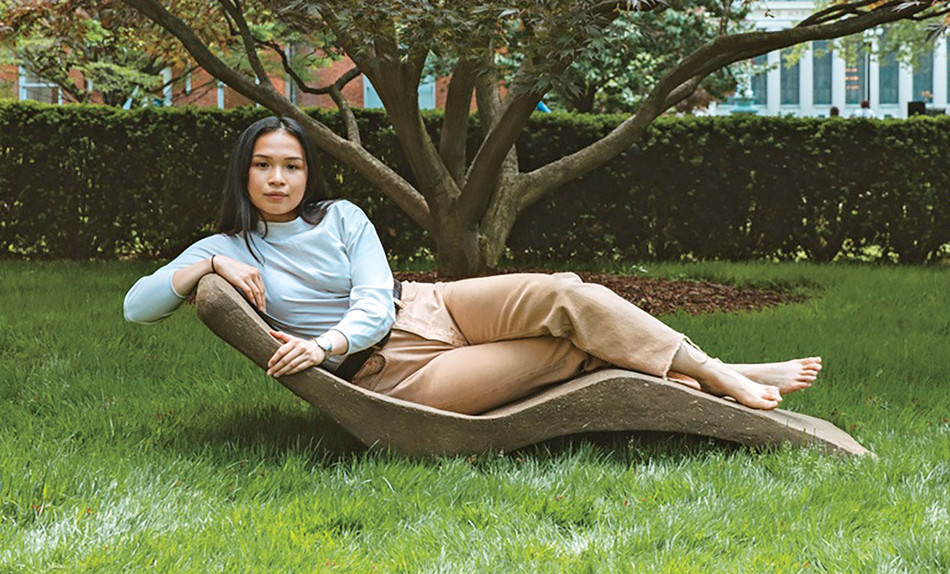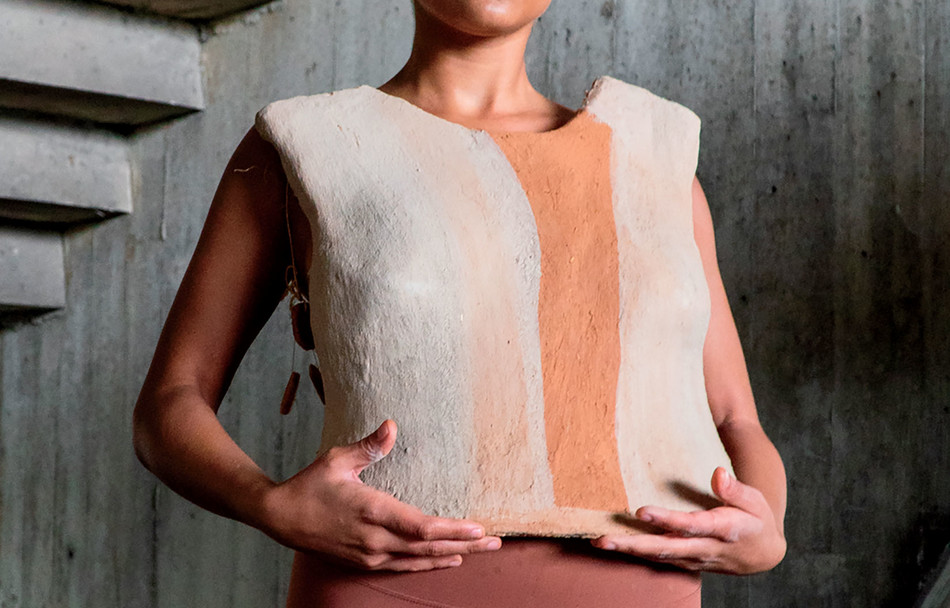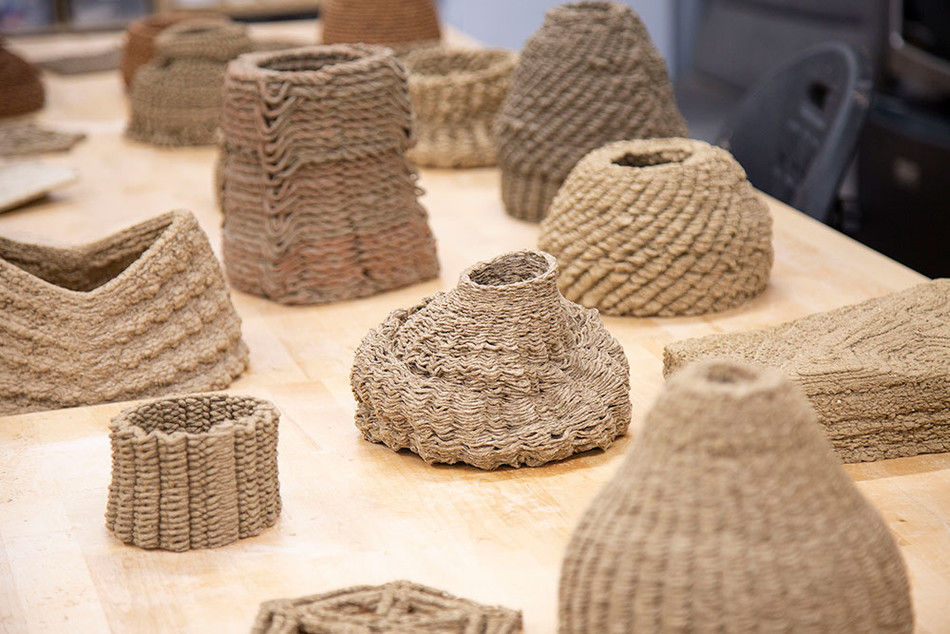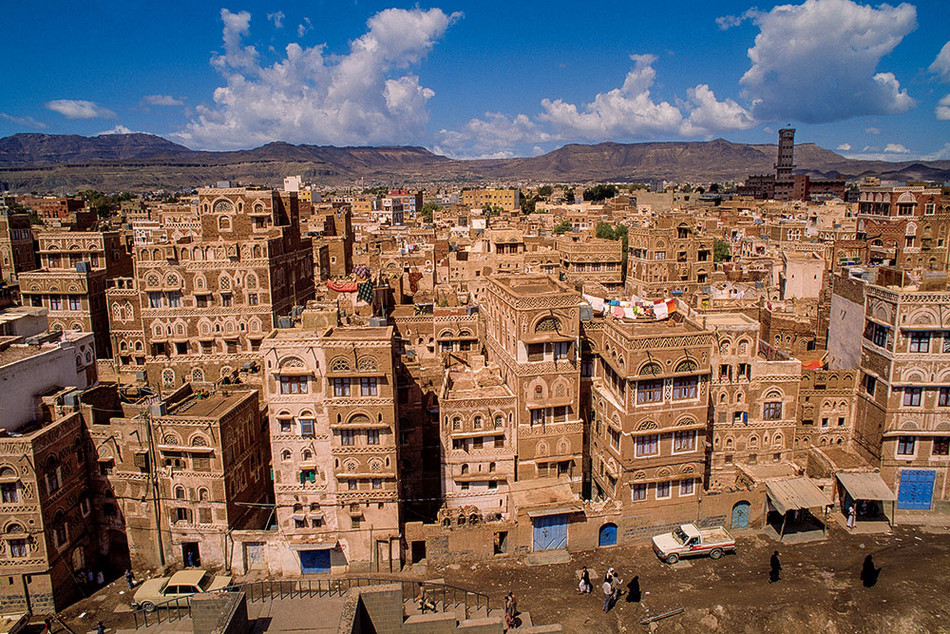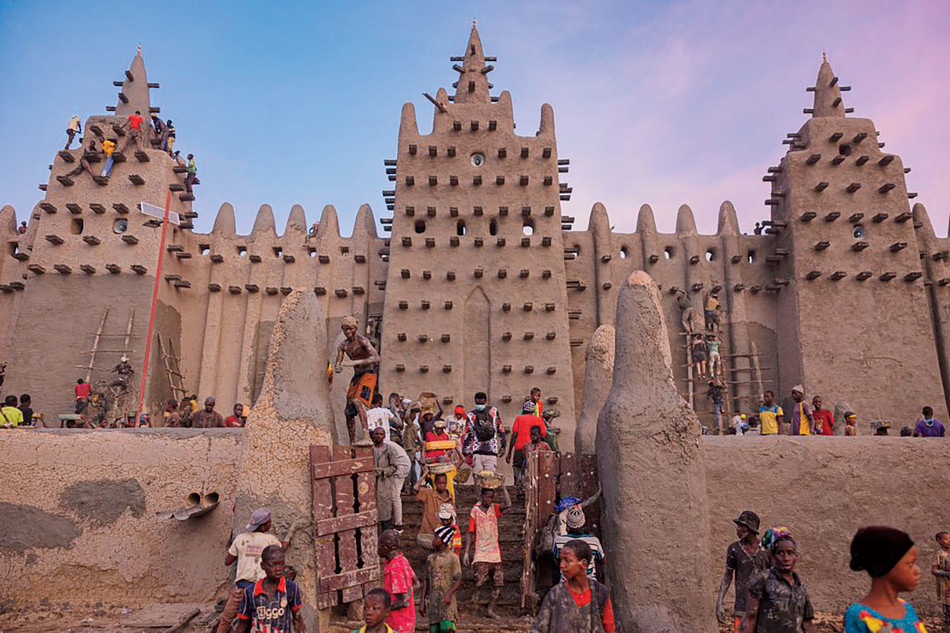Mud, Dung, Banana Fiber: Why Natural Building Materials Are Making a Comeback
The frontier of contemporary building technology runs through a narrow basement room where Lola Ben-Alon sloshes water into a tray of dirt and plunges her fingers into the muck.
She smears it between her hands to see if it cakes on her skin, then mashes it into a sticky lump. “You need to know how much clay is in the soil,” she says. “That’s the first criterion for determining if it’s suitable for construction.”
Ben-Alon, an assistant professor at Columbia’s Graduate School of Architecture, Planning, and Preservation, hopes to revolutionize the way we build, and her plan starts with a fistful of wet earth. Her various callings — as an engineer, curator, scientist, and hard-charging optimist — come together in the school’s Natural Materials Lab, which she directs. The research that she and her team conduct there is based on a straightforward premise: constructing with earth, plant matter, and even living organisms can go a long way toward healing the environmental damage wrought by concrete and steel.
As Ben-Alon works the brown goo between her hands, she treats this elemental clod of dirt as a portal into a vast field. “In the lab we look deeply at earth-based and natural fibers, and at their performance, material science, fabrication possibilities, politics, policy, and geographies.” She has one eye on the microscope to learn how the earth behaves, the other on the future, hoping to shape how society makes use of that expertise.
She’s just getting started. The lab, which took up residence in Schermerhorn Extension barely a year ago, looks more like an art room than the cradle of innovation. A 3D printer and an eleven-foot crane stand along one wall. Vats of soil, piles of brownish baskets, and plastic bags filled with stringy plant stems, husks, and straw occupy every surface. “We have dung!” she says, opening a sack. She gestures to another: “This is banana fiber.” At times, her analytical techniques can seem intuitive. “I listen to sand,” she says. “It’s a very deep conversation.” An angular, faceted grain works best for construction because it binds well. “So you crunch sand in your ear, and if it makes that chtkr chtkr sound, that’s good. Round sand, on the other hand, is better for finishes, because it makes a smooth, workable mixture. Totally different sound.”
That sensory approach is an essential part of the toolkit that Ben-Alon teaches her students, but it’s only step one. Each day at the lab is part of a multi-phase movement that requires patience, rigor, and realism. It begins with stirring together experimental blends of sand, soil, clay, water, and fibers, then turns to analyzing how well different variables affect their plasticity, strength, and resilience. “We’re swimming in a pool of endless possibilities,” she says.
Maximizing options has always been part of Ben-Alon’s strategy. She was born and grew up in Israel — “in a small southern town near the Negev where you’re expected to have kids when you’re twenty and not do much more than that,” she says. “But I was hungry.” She got herself into a selective school and quickly developed what would become a characteristic mixture of ambition and flexibility. “It was a dance school, so I danced,” she says with a shrug. She aspired to be an architect but instead was offered a scholarship to study engineering at the Technion, Israel’s prestigious technical institute, so she grabbed it. “I remember telling myself, architecture will come someday. It will come.” (She also merged her scientific training with her art-school sensibility and earned a diploma in critical and curatorial studies.) Ben-Alon had just gotten married when she was accepted into a Carnegie Mellon PhD program that could have been designed specifically for her: architecture, engineering, and construction management. “I said to my husband, ‘OK, you’re coming with me to Pittsburgh.’”
That series of hairpin turns in her trajectory has made her comfortable with the notion of trying something first and only afterward tallying up the reasons. “Ours is a doing practice,” she says of the Natural Materials Lab. “My collaborators and I seek to understand the mineralogy of the material, then do a little microscopy to see the interaction. But mostly we try to work with something, and if it goes well, we try to figure out why.”
For Ben-Alon, the ideal result of all this trial and error would be a catalog of standardized low-carbon products like prefabricated rammed-earth wall panels, natural-fiber insulation batts, and clay-rich finishes, all of them cheap, reliable, and abundant enough to replace today’s fiberglass, metal façade assemblies, oil paint, and synthetic foam. At the current, artisanal stage, she and her team are feeding each amalgam into a 3D printer. “It should look more like cookie dough than pancake batter,” Ben-Alon says. “As you push material through a nozzle, the fibers will align in a certain way, and once I know the direction of its structural integrity, I can create more complex geometries.” The often frustrated hope is that these concoctions will yield elaborate tiles, weaves, vessels, and textiles.
She makes a thirty-step tour of the lab, pointing out perforated tiles, scraps of imitation leather, rolls of mesh, garlands of rope, and a structure that looks like a scale model of three intertwined skyscrapers. All are made of fiber and earth. Ben-Alon is far from alone in pursuing her dream. She and Penmai Chongtoua ’22CS, an associate researcher, have created clothing made from their own “BioEarth fabric,” which is composed of at least 60 percent soil. Another colleague, Harris Wang, an associate professor in the Department of Systems Biology and the Department of Pathology and Cell Biology at Columbia University Irving Medical Center, has created living bacterial bricks made from mycelium, the branching roots of common fungi. Farther afield, venture capital is financing startups like Biomason, which produces cement grown by microorganisms rather than ground from fired limestone.
With so many startups, designers, and researchers drawn to the field, there is an urgent need to develop testable standards for the manufacture of these materials and their use in construction. Ben-Alon already has extensive experience on that front, since she wrote an official addendum to the International Building Code that covers cob, a hand-moldable mixture of soil and fiber that is energy-efficient and durable. “Cob has been used everywhere, including in the US, but there was no permitting process, so people used it either illegally or for tiny structures, less than 120 square feet. Now there’s an approved construction method and safety standards, so it can be used much more broadly.”
Well, it could be, anyway. Maybe that one chapter in the code will indeed unleash a cascade of new cob construction, but that will depend on the willingness of investors, lenders, insurers, and contractors to take risks on a new-old practice. “There’s no way to reduce carbon without providing financial incentives,” Ben-Alon acknowledges. “That’s way beyond the scope of what I’m doing — I’m still looking at the microstructure of the soil!”
And yet codifying the use of natural materials will help with the biggest, most amorphous challenge: overcoming suspicion and disdain. The first thing everyone wants to know about earthen construction is whether it falls apart in the rain. A few thousand years of experience would suggest it doesn’t. “The thing about earth-and-fiber material is that if it gets wet and then the water evaporates, that’s fine,” Ben-Alon says. Adobe blocks can be weatherproofed with clay plaster or lime, though she does advise raising the structure on a stone base and protecting it with a three-foot roof overhang — what she calls “a good pair of boots and an umbrella.” Rain is far from the only environmental threat, of course, but the elasticity of mud-and-fiber construction also holds up well to earthquakes. And anyone who fears that such buildings will simply crumble away without steel or concrete backbones need only take a look at the city of Sana’a in Yemen, where rammed-earth apartment buildings have been standing for centuries.
Cities have always been made from stuff that springs from the ground beneath our feet — granite, marble, wood, concrete, and glass. And until a few decades ago, the connection between source and building site was clear. “How this city marches northward!” the New York diarist George Templeton Strong 1838CC enthused in 1850. “Streets are springing up, whole strata of sandstone have transferred themselves from their ancient resting-places to look down on bustling thoroughfares for long years to come.” That image of the mountain coming to Manhattan embodied the optimistic nineteenth-century vision of nature as an infinite resource, the raw stuff of prosperity.
Today, the relationship between natural and built environments looks far more perilous. Climate change menaces cities in ever more ferocious ways, giving architects and engineers new threats to resist and to mitigate: storm surges, flooding rivers, heavy rains, rising sea levels, wildfires, and heat waves. Some solutions exacerbate the problem. Sultry weather demands more air conditioning, which pumps out more heat. Buildings are responsible for 40 percent of the world’s carbon emissions, a melancholy contribution divided between the energy it takes to keep the lights on and the temperature stable and the gases produced in erecting new construction. A contemporary office tower, for instance, is an agglomeration of highly processed components manufactured in specialized facilities all over the world and hauled across oceans at immense environmental cost — concrete structure, façade panels, drywall, insulation, ducts, wires, motors, hardware, finishes, and so on. And when that whole assemblage has outlived its usefulness, it often gets thrown away. That’s because industrially produced buildings are cumbersome and expensive to preserve. Once-standard pieces of hardware become impossible to find, computer-controlled systems can’t be tweaked, factories that supplied elaborate window assemblages go out of business. In 2000, when the Manhattan midcentury office landmark Lever House had grown shabby, architects reskinned the entire building in a new curtain wall — preservation by replacement. That’s rarely possible with contemporary buildings, which is why financial models often figure a new commercial building’s lifespan at around twenty-five years, and the more sophisticated the technology, the more quickly it ages. The real-estate business’s term of art for areas with an oversupply of older buildings is “under-demolished.”
Ben-Alon hopes to reduce all that waste by applying today’s technology to prehistoric techniques, using materials that are ubiquitous, non-polluting, widely available, and highly versatile. She’s fighting a battle on multiple fronts, from the microscopic to the cultural, trying to overcome the perception that her grass and dirt stews are precious and impractical.
That movement is spreading perhaps because it combines idealism with hard-headed pragmatism. Structures that are erected by hand using local knowledge and materials are designed for easy upkeep. Perhaps the most spectacular example is the Great Mosque of Djenné, in Mali, built in 1907. Every year, men, women, and children turn out by the thousands for a joyous festival to reslather its earthen parapets and turrets with a mixture of soil and water called banco. “I’m not saying that everyone should build houses out of mud and replaster every year, as they do in West Africa,” Ben-Alon laughs. Rather, she believes that the wisdom of vernacular construction can be imported to Western cities. “In Europe, we’re starting to see new three- and four-story multifamily structures made of mass timber, infilled with straw panels, and plastered with lime and clay. In Paris, there are three manufacturers of compressed-earth block.”
Translating ancient practices that are scattered worldwide into a manual of instructions or a universal product is a daunting quest. For one thing, each material maker will be working with different raw ingredients. Even something as basic as soil is infinitely various and irreducibly local. Techniques for using it are usually learned by imitation. The architect Juan José Santibañez, for instance, has devoted a lifetime to studying and designing earthen structures in the Mexican state of Oaxaca. “I learned to pay attention to what the old people do — tradition, not science,” he says. Santibañez, like Ben-Alon, likes to plunge his arms into wheelbarrows full of mud, mixing it around to get a feel for its properties. But it’s Oaxacan mud, a substance he knows by touch.
Ben-Alon understands the challenges of standardizing such experience-based design, but she still hopes to smuggle her grimy-paw ethos into the capitalist system. Doing so need not involve a complete rejection of building-as-usual. “We shouldn’t fall into the trap of thinking we need to replace concrete and steel. It will not happen. Concrete and steel are not the enemy.” The enemy is the habit of using them by default.
She has scant interest in persuading institutional clients and glamorous architects to erect all-adobe museums. A deluxe organic one-off won’t make much of an impact, no matter how green it claims to be. She’d rather take a quieter, more promising route, developing affordable off-the-shelf organic components. The future, Ben-Alon insists, lies in the aisles of home-improvement stores. That may seem an unlikely front for radical change, but she has confidence in the combination of growing urgency and rigorous innovation. “Once these products show up at Home Depot,” she says, “I’m retiring.”
This article appears in the Fall 2023 print edition of Columbia Magazine with the title "Building from the Ground Up."
